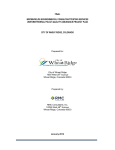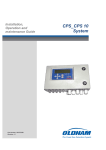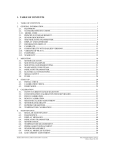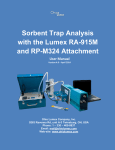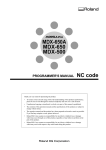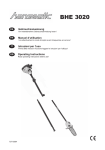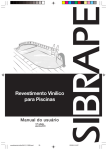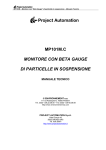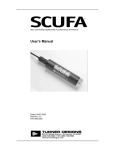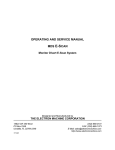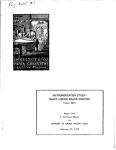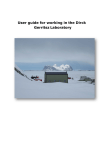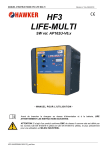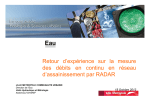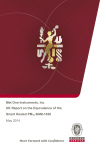Download - DNP International
Transcript
Company Profile DNP INTERNATIONAL is a company specialized in design and development of industrial analyzer systems, with several years of experience in design, development, commissioning and start-up of complete process analyzer systems for almost any application. We have the ability to provide full service for on-line analyzer systems. Whether the process in your company requires a simple sample system or -component, a single-stream analyzer or a complete integrated analyzer; DNP is qualified to design and produce according to your specific demands. Today, DNP has a long list of satisfied customers in all most all segments of the markets like Power, Petrochemicals, Refineries, Steel Plants, Fertilizers, Chemical Plants, Cement Plants, Pharma & Biotech, Oil & Gas, Water and Waste water treatment Plant, Municipal Sewage and Drinking water Treatment Plant, Glass manufacturing units, Research Institutes, Technical Education Institutes and so on. History: DNP INTERNATIONAL was founded and registered on May, 2005 as a privately owned company. Our independence enabled us to maintain an unbiased approach to our clients and their requirements and to provide a complete product. The priory activities are the sales and services of online analyzers. Over the years DNP became a reputable full service Analyzer Systems Integrator. The combination of Analyzer Manufacturer Representative and Analyzer Systems Integrator gives the final user customer the assurance of complete analytical systems with full single source responsibility. Profile: DNP has the ability to provide full service to clients requiring high quality analyzer systems. This extends from providing initial surveys, both in the field and in the office, till final commissioning and maintenance of complete analytical systems. We make dissimilarity between the following activities: 1. Analyzers: all activities in reference to the sales of analyzers and contacts with the represented analyzer manufacturers. 2. Analytical systems: all activities in reference to engineering, design and production of analytical systems. 3. Support & service: all back-up and after sales activities of the analyzers and analytical systems division. The service covers outlined: Consulting System specification and engineering Detailed engineering, equipment selection and specification Project management System design Fabrication and assembly of analytical systems Site management Pre-commissioning and commissioning of systems DNP Team Support Solution Full Fledged Service Center Fully Equipped Service Centre Facility Service through trained engineers In house as well as On-site Service facility Maintain a stock of critical spares to ensure Minimum downtime Service Maintenance Contract Comprehensive Non-Comprehensive Turn Key Projects All back-up and after sales activities of the analysers and analytical systems. The service covers outlined: Training Training is vital aspect to the success of instrument performance Hands-on Training work shop Special Training course designed as per customers requirement Free Service and Training camp Consulting; System specification and engineering; Detailed engineering, equipment selection and specification; Project management; System design; Fabrication and assembly of analytical systems; Site management; Pre-commissioning and commissioning of systems. Business Solution Environment Solution Waste Water Municipal & Industrial Waste Water Municipal & Industrial Waste Treatment Plant Water Treatment Plant COD BOD TOC NH4 H2S PAH DO Flow Air Emission Gases Continuous Emission Monitoring Continuous Emission Station (CEMS) Monitoring Station (CEMS) SO2 O2 CO2 HF Hg Dust Pressure pH Conductivity TSS Phosphate MLSS Oil Nitrate Level NOX CO HCL NH3 THC Flow Temperature Air Air Quality Monitoring Station Quality Monitoring (AQMS) Station (AQMS) SO2 NOX CO CO2 Ozone PM2.5 PM10 VOCs Heavy Metals Meteorological parameter: (Wind, Speed, Temp., Pressure) Process Solution Gases Water Process Gas Analyser Steam & Water Analysis System (SWAS) H2S CH4 CO CO2 Silica Sodium PO4 O2 C2H2 NH3 NCl3 Hardness pH Conductivity Acetyline CS2 TOC ORP Turbidity Formaldehyde Acetaldehyde Chlorine Ozone Refractometer Butene Tolune – Xylene Hydrazine Alkalinity Dissolved Oxygen Waste Water Automation System DNP is your specialist in the field of Municipal Sewage Treatment Plant (STP) & Industrial Waste Water Treatment Plant (WWTP) water analysis and sensors. We are qualified to design and produce according to your specific demands and can also provide completely integrated analyser stations or a measurement network. We offer specific sensors and analysers which can be placed directly in water or can be used as by-pass system, which in a very short period gives insight in the water composition. Because of this it is possible to realize continuous marking or automatic process control. Process control or marking can be executed on parameter level or water quality change. DNP has the abilities and facilities to provide full service to clients requiring advice, supply and maintenance of analysis systems of high quality. Commonly used analyzer for Waste Water Treatment Plants are; Total Organic Carbon (TOC) Nitrate and Nitrite COD Benzene BOD Chlorophyll A Total Suspended Solid (TSS) Chromate Oil in Water pH Ammonia Conductivity Hydrogen Sulfide (H2S) Chlorine Ammonical Nitrogen Colour Dissolved Oxygen Hydrocarbons Sludge Level and MLSS Phenol Phosphate Chromium (Cr6) Antimony (Sb), Arsenic (As), Bismuth (Bi) Cadmium (Cd) Chromium (Cr) Cobalt (Co) Copper (Cu) Gold (Au) Iron(Fe) Lead (Pb) Mercury (Hg) Drinking Water Automation System DNP is your specialist in the field of Drinking Water Plant water analysis and sensors. We are qualified to design and produce according to your specific demands and can also provide completely integrated analyser stations or a measurement network. DNP has the abilities and facilities to provide full service to clients requiring advice, supply and maintenance of analysis systems of high quality. Commonly used analyzer for Drinking Water Plants are; Flow Level pH Analyzer Conductivity Analyzer Chlorine Analyzer Hardness Analyzer Manganese (Mn) Silver (Ag), Selenium (Se) Thallium (Ti) Molybdenum (Mo) Nickel (Ni) Zinc (Zn) Level Flow DM Plant Automation System DNP is your specialist in the field of Demineralise (DM) Plant water analysis and sensors. We are qualified to design and produce according to your specific demands and can also provide completely integrated analyser stations or a measurement network. We offer specific sensors and analysers which can be placed directly in water or can be used as by-pass system, which in a very short period gives insight in the water composition. Because of this it is possible to realize continuous marking or automatic process control. Process control or marking can be executed on parameter level or water quality change. DNP has the abilities and facilities to provide full service to clients requiring advice, supply and maintenance of analysis systems of high quality. Commonly used analyzer for DM Water Plants are; Silica Analyzer Sodium Analyzer Total Organic Analyzer Copper Analyser Flow pH Analyzer Conductivity Analyzer Chloride Analyzer Iron Analyser Cooling Water Automation System DNP is your specialist in the field of Cooling Water Plant water analysis and sensors. We are qualified to design and produce according to your specific demands and can also provide completely integrated analyser stations or a measurement network. We offer specific sensors and analysers which can be placed directly in water or can be used as by-pass system, which in a very short period gives insight in the water composition. Because of this it is possible to realize continuous marking or automatic process control. Process control or marking can be executed at parameter level or water quality change. DNP has the abilities and facilities to provide full service to clients requiring advice, supply and maintenance of analysis systems of high quality. Commonly used analyzer for Cooling Water Plants are; ORP Analyzer Chlorine Analyzer Alkalinity Analyzer Total Suspended Solid (TSS) Analyzer Oil in Water Analyzer pH Analyzer Conductivity Analyzer Chloride Analyzer Silica Analyzer Steam & Water Analysis System (SWAS) Features: Truly designed as per ASME PTC 19.11 recommendations Compact double helix type, shell & tube sample coolers First time All the High Pressure components upto Pressure reducer can withstand temperature upto 550deg C. (i.e. Valve to Pressure reducer) Automatic High Temp. Shut-off valve are used for high temperature protection The Entire system is protected upto 600Deg F upto High Temp. Sample Shut-off valve No Power Supply required. No wiring !!!!! Rod-in-Tube type pressure reducer for High pressure sample lines as recommended by ASME PTC 19.11 On line pressure regulator cleaning No Filters are used Back pressure regulator with Stainless steel diaphragm Easy access of components. Stainless Steel Cooling water pipeline Totally Maintenance free VRTS Sample Cooler Back Pressure Regulator High Temp. Shut-off Valve Sample Filter VRTS On-line Water Analyser for Process Monitoring Multiparameter Controller pH / ORP / Conductivity Dissolved Oxygen (PPB) Dissolved Oxygen (PPM) Portable Sludge Level Ozone/ Chlorine/ ClO2 Ammonia / Phosphate Silica / Phosphate Analyzer Sodium Analyzer Turbidity & TSS Analyzer Hardness/Alkalinity/Ammonia Oil in Water Hydrazine/ Oxygen Nitrate Analyzer TOC Analyzer Portable DO (PPB) - Optical On-line Water Analyser for Environment Monitoring Our technology based on UV spectroscopy offers unparalleled reliability and very low operating cost. UV - Vis Spectroscopy The measuring principal is based on the UV light absorption spectroscopy. The water circulating in a flow cell is illuminated with a UV source (Xenon Lamp). The Spectral composition of the light going through the cell is analyzed and the quantity of light absorbed by organic matter is measured according to the Beer-Lambert Law. UV spectroscopy does not require reagent addition, nor does it require direct contact between the detector/emitter and the sample. No 1 2 3 4 Element Xenon Lamp Flow cell Beam splitter Peak filter No 5 6 7 Element Peak detector Reference filter Reference detector Patented Clogging-free flow cell Advantages: Low maintenance No drift or premature ageing of the detector The patented Flow cell allows very high level of suspended solid without clogging Fast: The measuring time is less than 10 seconds for most parameters. For ammonia (NH4) and H2S (measurement in gas phase), and for phosphate (measurement by colorimetry), the measuring time is about 3 minutes. Compact and Easy The new mechanical design allows analysis of up to 12 different parameters in a one single analyzer, thus reducing its size and its cost. No preparation of the sample is required even for highly charged effluent. Our patented flow cell and the diameter of the tubing avoid the risk of clogging. In case of high concentration of suspended solid it is possible to add a settling down time before the measurement to avoid interference due to the particles. Multiplexing Up to 6 streams When different streams need to be analysed, for example inlet and outlet of a plant, a optional multiplexing system delivers relay contacts to control external electric-valves or external pumps. Up to 6 different streams can be selected. The measuring channels can be either duplicated (each one having its own 4-20ma output or MODBUS register), or measured sequentially to fit with the maximum of 16 measuring channels (a MODBUS register indicates which stream is currently being measured). Water Analyzer Solenoid valve UV254 COD/BOD/TOC Ammonia Hydrogen Sulfide Oil Phenol Hydrocarbons Nitrate NO3 Colour Turbidity TSS Dissolved oxygen pH Conductivity Benzene Chlorophyll A Chromate BTX Phosphate Rhodamine Cr6 Ammonia (NH4) & Hydrogen Sulphide (H2S): A UNIQUE method UV gas absorbance after stripping No 1 2 3 Element Stripping pot Temperature probe Flow cell No 4 5 6 Two methods for absorbance spectrum treatment Element Air pump Xenon Lamp Spectrograph The ammonia and hydrogen sulphide measurement are based on the UV absorption of the ammonia gas or hydrogen sulphide gas after stripping phase. Consequently, the turbidity or colour of the sample has absolutely no influence and measurements can even be carried on activated Sludge. The ammonia gas has a typical periodic absorption spectrum that is analysed using a Fast Fourier Transform (FFT) that brings an exceptional selectivity. No interference has never been reported after years of operation on many different applications. A small quantity of NaOH solution is added to the sample for ammonia, or hydrochloric acid for hydrogen sulphide. Advantages: Unique method No effect of colour or suspended solid, tested on activated sludge Absolutely no interferences Fast responce time: 3 minutes Oil in Water (PAH) – UV Fluorescent UV-VIS Fluorescence No 1 2 3 Element Xenon Lamp Emission filter Flow cell Advantage: High sensitivity Short response time Low maintenance No 4 5 6 Element Excitation filter Photomultiplier Reference detector COD Analysis – UV Spectroscopy Working Principal: UV - VIS Spectroscopy: The measuring principal is based on the UV light absorption spectroscopy. The water circulating in a flow cell is illuminated with a UV source (Xenon Lamp). The Spectral composition of the light going through the cell is analyzed and the quantity of light absorbed by organic matter is measured at 254nm according to the BeerLambert Law. UV spectroscopy does not require reagent addition, nor does it require direct contact between the detector/emitter and the sample. Unique Features: UV - VIS Spectroscopy For IWWTP / STP Plant Meets Regulatory norms Analyzer SCAN the sample between 180 and 800 nm in order to measure a pollutant in a complex matrix. The UV Xenon Lamp is specified for 109 flashes which corresponds to a life time of 10 years on the basis of one measurement every minute. No preparation of the sample is required even for highly charged effluent. The measuring time is less than 10 seconds. Mutiplexing System allows measurement in more than one sample stream. Maintenance Free Reagent-less BOD/TOXICITY Analysis We detect the BOD using the plant’s own biomass and determine the toxicity with highly sensitive bacteria, fast and reliable. BioMonitor ® The miniature WWTP BOD: 1 – 200,000 mg/l Toxicity: 0 – 100% Respiration in mg O2/l * min Response time: 3 – 4 min. High grade decomposition Active sludge activity BOD Monitoring Environmental protection Clarification plant protection For the control and optimization of clarification plants The BioMonitor® work like a miniature clarification plant. The plants own activity sludge decomposes the content of the waste water and the oxygen necessary to do this is measured. This process takes place in the waste water cascade of the analyser, functioning exactly as it would do in an aeration basin. The nitrification’s respiration inhibition test Continuous monitoring Self regenerating breeding of bacteria in analyser High Sensitivity No extra purchasing of test organism necessary High reproducibility No memory effects NitroTox ® ToxAlarm® Toxicity: 0 – 100 % Response time: <5 min. Surface water Drinking water Ground water Laboratory application The bacteria, regenerated in the analyser itself, consume oxygen when converting ammonia into nitrate. The biomass is highly sensitive against a huge number of toxic substances. Toxicity: 0 – 100 % Response time: <5 min. Clarification plant protection Protection of the nitrification process of a clarification plant These substances cause an inhibition of the bacteria’s respiration which in turn leads to a decrease in oxygen consumption. Form this conclusions can be drawn about the toxicity of the sample. TOC Analysis From complex industry waste water to pharmaceutical pure water, our TOC analysers determine the parameter quickly and precisely. The measurement system for the rough Combustion at 1200°C Catalyst-free Salt conc. Up to 30% NaCl High particle content samples No memory effects Low maintenance Quick TOCultra True TOC: 0.1 – 50,000 mg/l Response time: 1 min. (TC) TC/ TOC/ COD/ TNb Up to 6 sample streams Exact determination of TC, TOC, (TRUE TOC) and TIC Proven thermal oxidation principle Highest combustion temperature available (1,200°C) Catalyst-free Fast response time of one minute (TC) Multi-stream measurements (optional) Individual programmable operator access levels Analyser availability minim. 98% Maintenance and service max. 30 min per week Exceptionally low maintenance and operational costs Quick TOCairport TRUE TOC: 0.1 – 50,000 mg/l Response time: <3 min. Automatic switching between measurement ranges The patented LAR high temperature method at 1200°C guarantees the complete oxidation of all organic particles. Expensive catalysts are not necessary. In addition to, this its robust technique stands out by its minimal maintenance and operation requirements. Quick TOCuv Quick TOCpurity We light up the dark. TOC: 0 – 2000 µg/l TC/ TOC/ DOC UV persulfate Continal measurements Autocalibration Up to 2 sample streams Specific solutions for pure water Combustion at 1200°C TC/ TOC determination Patented QuickCalibration High sensitivity 1) Sample transport via injection system a) Extraction of sample from sample stream b) Injection through valve c) Rinsing of the injection needle. 2) Combustion, oxidation to CO2 3) CO2 concentration measurement 1,200 °C, At water samples are completely and precisely analysed. TOC: 10 – 2000 µg/l TOC: 0.1 – 10 mg/l Process water Quick TOCcondensate TOC: 0 – 2000 µg/l Samples up to 90°C Boiler feed water Condensate return Quick TOCpharma TOC: 0.1 – 2000 µg/l 21 CRF Chapter 11 Pharmaceutical HWP / WFI Quick TOCeffluent Simple effluent measurements TOC: 0.1 – 200 mg/l Waste water effluent Water course monitoring Surface water monitoring Drinking water TOC Analyzer for Pharmaceutical Water Precise continuous TOC analyses in low ppb ranges for pharmaceutical water Easiest Calibration and Validation According to USP Chapter 643 - EP 2.2.44 Software according to 21 CFR Chapter 11 QuickTOCpharma is an on-line measuring system for the detection of total organic carbon (TOC) in pharmaceutical water particularly for "Highly Purified Water" (HPW) and "Water for Injection" (WFI), according to USP Chapter 643 and EP 2.2.44. Features and benefits Software according to 21 CFR Chapter 11 Catalyst-Free Technique Easiest Calibration and Validation Highest Combustion Temperature (1,200°C) Fast Response Time of 3 Minutes Closed System to Prevent Contaminations No Memory effects Multi-Channel Measurement (Optional) Measuring Principle The TOC is measured by injecting small defined sample volumes into the carrier gas stream that circulates continuously through a high temperature furnace where the water vaporizes and all carbon compounds are converted safely to CO2. Calibration and Qualification With the unique calibration method of the Quick- TOCpharma for which LAR has filed a patent it is now possible to check easily the system for correct functioning at any time. For this a calibration gas is used during the calibration period. It is injected into the measuring system similar to the water sample. With the extremely high combustion temperature of 1200°C the complete oxidation of all organic compounds is guaranteed. With this easy procedure the system can always be controlled. The furnace temperature is of course monitored continuously and it is therefore ensured that measurements can only be performed at the specified combustion temperature. TOC Analyzer for Effluent Water Precise TOC Analysis especially for the Measurement Principle WWTP effluent The QuickTOCeffluent of LAR is an on-line Measuring system for the determination of total carbon (TC), total organic carbon (TOC) and dissolved organic carbon (DOC) according to DIN EN 1484, ISO 8245 and EPA 415.1. The QuickTOCeffluent is suitable for almost every TOC measurement at the effluent of industrial and municipal waste water treatment plants. Typical on-line applications are the combined effluent monitoring of TOC and TNb in one single analyser. As a result the maintenance efforts will be reduced significantly compared to multiple analysers operation. Thermal Combustion Technology The QuickTOCeffluent has been engineered to work without the aid of expensive catalysts by using temperatures of more than 1200°C. Conventional thermal catalytic methods use temperatures between 680° to 1000°C. Therefore, even difficult to combust compounds are oxidized effectively and rapidly, regardless of their composition. Features and benefits Measure according to DIN EN 1484, ISO 8245 and EPA 415.1. Catalyst- Free Technique Highest Combustion Temperature (1200°C) Highest Reproducibility Lowest Maintenance Efforts Lowest Operational Costs Self- Explanatory Software Infrared Detection Response Time (2 - 3 Minutes) Easiest Operation TNb Detection Simultaneous (Optional) No Filtration Necessary at the Effluent COD Analysis With our analyzers, the chemical oxygen demand is cleanly and safely determined online, without using hazardous chemicals. The online COD measurement system from LAR, based on their innovative process management, enables an accurate and environmentally friendly determination of the COD themselves to working online. Quick CODultra_o The high temperature method COD: 0.1 – 200,000 mg/l Response time: 3 min. Highest combustion temperature available (1200°C) Reagent-free Determination of the real oxygen demand Proven thermal oxidation principle Catalyst-free Salt conc. Up to 30% NaCl Multi-stream measurements (optional) Individually programmable user levels Analyser availability minimum 98% Maintenance and service max. 30 min per week Quick CODultra_i The correction method COD: 1 – 150,000 mg/l TC/ TOC/ COD measurements Measurements without reagents TOC/ COD correction With the ultra-series from LAR, operation is through the easy use of a touch screen or optionally it can be controlled via remote over a network con ® Elox100 The electrochemical oxidation The patented method produces and uses OH radicals as oxidants by use of an electrical potential on an electrode. COD: 1 – 100,000 mg/l Response time: < 4 min. Electrochemical oxidation Easy operation and maintenance Free form chloride disturbances High oxidation potential No memory effects Waste water treatment Process control COD. The cleaner methods. THE PRINCIPLE. Even when the water is dirty the measurement is clean! The Elox100® works without dangerous or caustic substances, offering a highly safe and simple operation. 1) Sample transport via injection system a) Extraction of sample from sample stream b) Injection through valve c) Rinsing of the injection needle. 2) Combustion, oxygen consumption 3) O2 measurement 1200 °C At , water samples are completely and precisely analysed. Total Bound Nitrogen (TNb) & Total Phosphor (TP) Analysis TNb and TP are important parameters for waste water treatment. We are the only one who offer a combination of these with TOC and COD in one system. QuickTONb The reagent free TNb measurement N: 0.1 – 200 mg/l Combustion at 1200°C Response time: 1 – 2 min. Measurement of the sample including particles Consistent recovery from ammonia and nitrate nitrogen High salt content possible Waste water treatment Process control The LAR high temperature method guarantees a complete oxidation for all nitrogen bonds in sample. Salt contents are dissolved at this temperature without a problem. Advantageous in comparison to the wet chemical methods is that the all particle bound nitrogen is completely detected. The high reaction temperature guarantees the consistent recovery from ammonia and nitrate nitrogen. QuickTOCNPO 4 in 1 - The combi-analyser TOC: 0.1 – 200 mg/l TNb: 0.1 – 50 mg/l TP: 0.01 – 4 mg/l COD: 1 – 600 mg/l Combination at 1200°C UV oxidation Molybdenum blue method COD correction Process monitoring Industrial and communal clarification plants Process control Water course Monitoring Optional number of parameters No memory effects TOC,TP,TNb and COD in one analyser. The measurement system from LAR, safely and reliably determines the total organic (TOC), the total phosphor (TP), the total bound nitrogen (TN b) as well as the chemical oxygen demand (COD). The TP is calculated parallel to the TNb and TOC measurements. this is carried out by mixing the untampered sample with UV persulfate and then leading it through a UV reactor. The COD is corrected to the TOC. Housings Depending on the requirements of an application, LAR offers a variety of protective housings for protection against corrosion and explosion: IP54 (Standard) NEMA 4X ATEX Zone I (T1 to T4) ATEX Zone II (T1 to T4) High Salt Option High Salt Concentrations. No Problem. Based upon the unique LAR high temperature method at 1200°C, salts are completely oxidised and led out of the reactor. Through the special process management and optimised reactor construction lengthy downtimes and the high following cost are minimized. Long-life reactor Clog-free No dilution of sample Samples up to 30 % NaCl Flow Measurement Channel Networks Wastewater Treatment Plants Process Water Hydrologic River Monitoring Irrigation Systems The perfect solution for each application Regarding flow measurement in water and wastewater we distinguish between two basic methods: Flow Velocity Measuring Methods We provide portable and permanent metering systems for continuous flow measurement using ultrasonic flow velocity measurement. For any liquid from clean water to wastewater and for a variety of flumes such as part filled and full pipes, channels and surface waters we supply appropriate measurement systems. Our innovative units stand for highest accuracy and measurement reliability combined with easy installation and straight forward operation. The Hydraulic Method (Q-h Relation) For classic flow measurement methods on Venturi flumes, weirs, dam shutter and similar applications, We provides appropriate metering and evaluation instruments. Flow Measurement We provides the best possible measurement method for all applications Wastewater Cross Correlation Method Water Doppler Method Transit Time Method The measurement method for universal use in slight to heavily polluted water Very high accuracy Measures the real flow velocity profile For measurement in slight to heavily polluted water Latest intelligent fourth-generation Doppler technology For clean to slightly polluted water Meets IEC 41 requirements Very high measurement accuracy Reflectors within the water (particles, minerals or gas bubbles) are scanned by an ultrasonic impulse and subsequently are saved as echo patterns. A second scan follows a few milliseconds later. Correlating both signals allows us to calculate the flow velocity. Repeating this procedure in varying flow levels enables determination of the real flow velocity profile The Doppler method uses a continuous ultrasonic signal with a defined frequency and a known angle to be sent into the water. The moving particles generate a frequency shift which is proportional to the flow velocity of particles. These values are used for statistical averaging. The Doppler method cannot be used to perform distance-related flow velocity measurements. The transit time method is based on detecting the transit time of ultrasonic signals between two sensors. Here the signal transit time towards the flow direction is shorter than against the flow direction. The difference between both transit times is proportional to the average flow velocity along the measurement path. The average velocity within the section is calculated by the transmitter. Flow Measurement Flow Velocity Measurement Methods Permanent Transmitters System Real flow velocity profile measuring Ex approval according to ATEX Internal 3-step controller Display / Operation Display size Keys Inputs 0/4 - 20 mA with 12 Bit resolution for external level and external setpoints 4 - 20 mA for external level (2-wire) Redundant level measurement Digital inputs Max. number of v-sensors Sedimentation measuring (WUS + ext. sensor) Outputs Relays Analog outputs Data memory Flash card / internal memory Data transmission Via plug-in compact flash card, TCP/IP, Ethernet and Modem (GPRS, ISDN, analog) Communication Rs232, TCP/IP via Ethernet/modem (GPRS, ISDN, analog), Modbus-TCP, int. web server Suitable sensors Areas of use Wastewater OCM Pro CF NFP OCM F ++ ++ + ++ - + ++ - + - - - + Zone 1 - Cross Correlation Method + Zone 1 - Doppler Method Zone 1 + 128x128 pixel 18 keys 128x64 pixel 6 keys 128x64 pixel 6 keys 4 - 2 1 + 4 3 + 1 1 - 1 4 1 - 5 4 2 3 5 3 + - - + - - + - - The top unit for universal use in wastewater For full pipes the cost-effective alternative to EMF For measurements in slight to heavily polluted water Water Portable Wastewater Water NivuChannel NivuSonic NivuSonic CO PCM Pro v PCM 4 PCM F PCO ++ ++ ++ ++ ++ + ++ ++ - - ++ ++ + - ++ - - ++ ++ + - ++ - - - - - - Cross Correlation Method + + Zone 1 - Doopler Method - Transit Time Method - - Transit Time Method + 128x128 pixel 18 keys 128x128 pixel 6 keys 128x128 pixel 6 keys 128x128 pixel 18 keys 128x128 pixel 18 keys 128x128 pixel 18 keys 128x64 pixel 5 keys 4 4 4 - - - Up to 2 1 4 8 paths - 4 2 paths - 4 2 paths - 1 + 1 1 + 2 + 1 1 + 2 + 1 1 + Up to 2 1 path - 5 4 5 4 5 4 1 - 1 1 1 1 Up to 2 Up to 2 + + + + + + + + + + + + + - - - + High accurate measurements in part filled and full pipes and channels Accurate measurements in full pipes Contactless and pressure independent measurement in full pipes The top unit for portable measurements in hazardous (Ex) areas For demanding portable measurements in non-Ex areas For portable measurements in slight to heavily polluted water Non-contacting measurement for portable long-term monitoring Bluetooth/ GPRS Bluetooth/ GPRS - External Modem GPRS Level Measurement Continuous Measurement Ultrasonic Table Of NivuMaster Series Transmitters NivuMaster L-2 NivuMaster 3 Relays Level measurement/ distance measurement ++ ++ Volumetric measurement/ empty space measurement ++ ++ Pump control/ slide valve control - + Volume measurement - ++ Comparative measurement - - Measurement on stormwater overflow tanks - ++ Operation Display Inputs Sensors / optional 4-20 mA / digital Outputs Relays / mA output Construction Wall mount IP 65 / DIN rail mounting 19” version (rack mount) Panel mount Ex approval according to ATEX Optional + 1/-/- 1/-/- 2/1 3/1 +/- +/+ + + Zone 0, 1 and 2 For measurement of distance, level and volumes as well as for pump control and extended control tasks. Zone 0, 1 and 2 The NivuMaster L-2 is our cost effective entry model. Sensor Type P-M3 P-03 P-06 P-10 P-15 P-25 P-40 0.07 to 2.4 m 0.125 to 3 m 0.3 to 6 m 0.3 to 10 m 0.5 to 15 m 0.6 to 25 m 1.2 to 40 m Sensor: P-Series Range NivuMaster L-2 NivuMaster 3 Relays NivuMaster LF-5:2 NivuMaster Plus ++ ++ + ++ ++ ++ + + ++ + + ++ ++ + ++ + + ++ - ++ ++ + ++ + + + + + 2 / optional 4-20 mA / - 2/-/- 1/-/- 2 / optional 4-20 mA / 7 x digital 5/1 5/2 5/2 6/1 +/+ +/+ +/+ -/- + + + + + - Zone 0, 1 and 2 Particularly designed f or storm water overflow tanks. For measurement and output of level and overflow volume. Zone 0, 1 and 2 Particularly designed for pump management, the NivuMaster Plus features 7 digital inputs. Zone 0, 1 and 2 For measurement of distance, level and volumes as well as for pump control and extended control tasks. + Zone 0, 1 and 2 Particularly designed for comparative measurements. Featuring two mA outputs for output difference and filling level. Pressure Measurement Continuous Measurement Hydrostatic, Pressure Pressure Probes for All Applications You can find appropriate pressure probes to connect to NivuCont Plus, NivuCont S transmitters or other evaluation devices with 4-20 mA inputs for each measurement application. Level Measurement Volumetric Measurement Comparative Measurement Measurements On Stormwater Overflow Tanks Submersible/Suspended Probes for clean to heavily polluted liquids NivuBar Plus II Ex NivuBar H II Ex NivuBar G II Ex Diaphragm Ceramics Ceramics Ceramics Measurement principle capacitive capacitive capacitive Ex Approval Zone 0 Zone 0 optional Zone 0 Measurement range 1, 2, 4, 6, 10 m water column/ other on request 0 - 20 m water column adjustable/ other on request 1, 2, 4 m water column/ other on request Fastening suspended on cable suspended on cable screw-in using 1“ thread Applications • Level monitoring in open tanks, flumes and basins • Wastewater treatment plants, water processing, pump stations, stormwater holding tanks, water supply NivuCont Plus Ex NivuCont S Continuous Measurement Ex High operational safety through integrated overvoltage protection Low installation efforts due to 2-wire loop powered technology Reliable operation in Ex areas thanks to Zone 0 protection Sensor bodies available in various materials such as PVC, Teflon or Hastelloy: resistive against aggressive liquids such as acids or bases Suspended probes available with only 17 mm diameter for measurements in wells or depth measurements Pump Control Volume Measurement for clean to heavily polluted liquids AquaBar Pressure Measurement for clean to heavily polluted liquids and gases AquaBar BS Pressure Measurement polluted liquids and gases for clean to slightly HydroBar G II Ex UniBar E Ex Stainless steel Stainless steel Ceramics Stainless steel Piezoresistive piezoresistive capacitive piezoresistive - - Zone 0 Zone 0 2, 4, 6, 10 m water column/ other on request 2, 4, 6, 10 m water column/ other on request 1, 2, 4, 6, 10 m water column/ other on request 1, 2, 4, 6, 10 m water column/ other on request suspended on cable suspended on cable screw-in using thread screw-in using thread • Environmental technology: water supply, wastewater treatment plants • Level monitoring in open tanks, flumes and basins • Depth measurement in wells • Groundwater level measurement • Level measurement in closed tanks and pipe systems • Environmental technology: water supply, wastewater treatment plants • Level measurement in closed tanks and pipe systems • Water supply GPRS Data Logger for Flow, Level and Pressure GPRS Data Logger Low-Power data logger with GPRS transmission to D2W Internet portal GPRS Wireless MicroPower Battery Online Data Recording Unlimited access to your measurement data via Internet Extremely long battery life of up to 5 years For use in Ex zone 1 Comprehensive possibilities such as remote parameter setting, alarm functions, monitoring and calculation of limit values via D2W - Device to Web Internet portal Stable and cost-efficient data transmission Digital Input/Output Analog Input/Output Alarms Flow Level Precipitation NivuLog Easy NivuLog Easy Sun NivuLog SunFlow NivuLog 2 Ex NivuLog 4 NivuLog PCM NivuLog PCM Ex Inputs 4 x analog / digital can be combined as required 2 x analog / digital can be combined as required 4 x analog / digital can be combined as required Outputs Input configuration 1 x digital 0 - 20 mA, 4 - 20 mA, 0 - 2 V, 0-10 V, Trigger, PWM, day counter, interval and frequency counter 15 V DC (66 mA) optional: 24 V DC (41 mA) 25000 cycles Standard or rechargeable battery pack or external power supply (7 - 30 V DC) From 1min. free configurable event-driven Wake up / online mode, eventdriven; cyclic from 10 min. free configurable - - 0 - 20 mA, 4 - 20 mA, digital, day counter, interval counter 0 - 20 mA, 4 - 20 mA, digital, day counter, interval counter 14 V DC max. 100 mA min. impulse length 20 ms 440000 cycles Standard or rechargeable battery pack 14 V DC max. 100 mA min. impulse length 20 ms 440000 cycles Standard or rechargeable battery pack - From 1min. free configurable event-driven From 1min. free configurable event-driven From 1min. free configurable event-driven Cyclic from 10 min. free configurable event-driven IP 67 Cyclic from 10 min. free configurable event-driven IP 67 Cyclic from 10 min. free configurable event-driven IP 67 240/100/100 mm 240/100/100 mm 240/100/100 mm Sensor supply Memory Power supply Measuring interval Transmission Interval Protection rating Dimensions (h/w/d) Easy: IP 66/ Easy Sun / Flow: IP 68 Easy: 165/86/58 mm Easy Sun / Flow: 574/295/70 mm Connection to PCM Pro (Ex) and PCM 4 (non Ex) - 440000 cycles Standard or rechargeable battery pack Samplers for Waste Water MAXX Samplers are the industry’s leader in reliable, long-lasting, quality water samplers. MAXX patented vacuum system technology of collecting samples brings the most accurate measurements of any wastewater samplers on the market today. MAXX vacuum technology delivers a significant improvement over peristaltic-pump technology for water sampling equipment. The fluid travels only through the intake hose to the metering chamber, and then through the discharge hose, eliminating cross-sample contamination from pumps, valves and distribution plates. Able to handle discrete sampling (into 24 bottles) or composite (into 1 bottle). Obtain and preserve a repeatable sample volume at a timed interval or after a predetermined volume of flow Available in portable, stationary & wall mount configurations to meet your sampling needs The MAXX Portable Sampler sets up easily and quickly in the field. Reduced maintenance and reliable results are assured. Tolerates Harsh Environments Ideal for ISO 5667-10 & EPA waste water sampling requirement Portable Sampler Stationary Samplers Fully automatic sampling according to the vacuum principle Vacuum System - The sample is extracted by means of a vacuum, that means the liquid is sucked up through the sample hose and led into a metering vessel in which the sample volume is adjusted. Peristaltic-pump water sampling equipment squeezes and pinches the tube in order to draw in the source liquid. This wears down the system more quickly, and takes less accurate samples. Vacuum technology water sampling equipment has no parts that wear down quickly. Sampler is able to draw reliable liquid samples for years without concern of replacement parts or inaccurate samples. Portable Flue Gas Analyser / Emission Monitoring Standard Package Includes: Meter with Sensor for O2 and CO Filter & Charging Adaptor Calibration Report Flue gas probe (600°C), Length 50 cm Carrying Case & User manual Measuring Principle: Infrared photometer (CO2) Electro-chemical cell (O2, CO, SO2, H2S, NO, NO2) Technical data: Parameters Smallest measuring ranges: Range CO 0 ... 300 / 10000 ppm NO 0 ... 300 / 1000 ppm NO2 0 ... 300/ 1000 ppm SO2 0 ... 300 / 2000 ppm CO2 0 ... 20 Vol% O2 0 ... 21 Vol% H2S 0 ... 200 / 2000 ppm NOx Measurement We have perfected this method for the measurement of nitrogen oxides in the concentration ranges of 1 % down to 1 ppt (part per trillion). Our NOx analyzers are monitoring continuously processes as well as ambient conditions around the world. Environmental applications A broad range of NOx analyzers for indoor, clean room, ambient, tropospheric and stratospheric monitoring. Automotive applications Car emissions have to follow more stringent rules: You will find exactly the right instrument for your application! Analyzers for hot, moist, or cold, dry sample gas, and including simultaneous measurement of NO, NO2 and NOx reading AK protocol. Industrial applications Whether combustion, waste incineration or power plant, most of the hot processes call for a measurement of the exhaust gas direct at the source by national laws and international standards. Semiconductor applications We provide solutions for a wide range of complex problems associated with CMP process control. This has been used successfully in manufacturing and development lines worldwide since 1996. Continuous Emission Monitoring System (CEMS) The Continuous Emission Monitoring System is a high-end environmental protection monitoring equipment developed and produced independently by our principal, which is mainly for the flue gas monitoring at the occasions such as various boilers, industrial kilns and waste incineration. The core products are high quality spectrometer gas analyzer and laser dust detection instrument, of which our principal possesses all the intellectual property rights. CEMS measure SO2,NOx by thermal wet method and measure O2 by zirconia method. CEMS are added by condensation device and COx module. Technical Specifications Gaseous Contaminant Monitoring Subsystem Items Specifications Gaseous Pollutant SO2 (0~300~5000)ppm NO/NOX (0~300~3000)ppm O2 (0~30)% CO (0~1000) ppm, (0~100)% CO2 (0~100) ppm, (0~20)% HCl (0~7~8000) ppm HF (0~1~10000) ppm Transmittance: 0-100%, 80-100% Particulate Concentration Opacity: 100-0%, 20-0% Extinction: 0-2.5, 0-0.1 Temperature TPF Pressure Flow rate Range (0~400)° Accuracy ±0.5%F.S Range (-5~5)kPa Accuracy ±0.5%F.S. Range (5~40)m/s Accuracy ≤5%F.S System Features: Two-step measurement, higher accuracy and better performance; Full components measurement, all parameters integrated into to a panel Higher accuracy, adopting hot-wet process to avoid SO2 being absorbed by condensed water; Analysis system connected to the measurement cell by optical fiber, easing installation and maintenance; Comparing to conventional condensation method, CEMS has no moving parts, featuring compact configuration and long maintenance interval; Higher reliability and lower ownership, eliminating the use of costly parts such as peristaltic pump, diaphragm pump and condensation system; Gas analysis uses the UV spectroscopy technology, which can deal with the negative effect on measurement from water and dust; Adopt unique filter to reduce dust more effectively and improve the blowback significantly, in turn obtain a longer maintenance interval. Continuous Emission Monitoring System for Incinerator (CEMS) Measuring Principal: The Analyzer is a single beam photometer. It’s based on the absorption of infrared light. For the calculation of a component’s concentration the measuring technology registration of unattenuated and attenuated intensity in the range of absorption wave lengths is required. Application: Multi-component gas analysis system for the use in official and process emission measuring systems e.g. for: Monitoring of the exhaust gas concentration of combustion plants with most diverse fuel (oil, gas, coal, biomass, substituting fuels, etc) as well as at the thermal waste treatment Combustion optimization Monitoring of process management Examples of Application: Power plants Waste incinerations Refineries Cement industry Industrial exhaust air Paper factories Glass industry Components, Low TÜV-approved measuring Range & measuring principle Meas. components: Max. 8 Infrared components + O + TOC (optionally) TÜV-Approval: TI-Air, 13th, 17th and 30th BImSchV TÜV-Report: 936/21203173/A CO: 0 ... 75 mg/m³ (Gas filter correlation) NO: 0 ... 200 mg/m³ (Gas filter correlation) NO: 0 ... 50 mg/m³ (Single beam dual wavelength) SO2: 0 ... 75 mg/m³ (Single beam dual wavelength) HCl: 0 ... 15 mg/m³ (Gas filter correlation) NH3: 0 ... 30 mg/m³ (Gas filter correlation) H2O: 0 ... 40 Vol% (Single beam dual wavelength) CO: 0 ... 20 Vol% (Single beam dual wavelength) NO: 0 ... 50 mg/m³ (Gas filter correlation) O2: 0 ... 25 Vol% (Zirconium oxide cell) TOC, CH: : 0 ... 15 mg/m³ TOC HF: 0 ... 20 mg/m³ (Single beam dual wavelength) (no TUV-approved measuring component) Air Quality Monitoring Station (AQMS) As a real-time monitoring system, Air Quality Monitoring System (AQMS) is designed to evaluate air quality, assess environmental and health risk, and predict potential air contamination accident. Awaring of the concentration and variation tendency of toxic and hazardous materials in ambient air, effective pollution control strategies could be generate to improve the quality of ambient air. AQMS measures multiple parameters including SO2, NOx, O3, CO, NH3, H2S, PM10 (2.5), VOCs, meteorological parameters, heavy metals, aerosol, etc. It can be used in routine of air quality, VOCs monitoring, haze monitoring, dust monitoring, greenhouse gas monitoring, traffic pollution monitoring (transportation routes automatic monitoring stations), acid rain monitoring, heavy metal monitoring, and so on. Technical specification: Product Name SO2 Analyzer Principle Ultraviolet Fluorescence NOx Analyzer Chemiluminescence Method O2 Analyzer Ultraviolet Absorption Method CO Analyzer Gas Filter Correlation Method Particulate Analyzer (PM2.5 &PM10) β Ray Absorption Technique Zero Gas Generator Dynamic Calibrator Key Parameter Range:0-50ppb to 0-20ppb(Dual ranges and auto range supported) Noise:<0.2ppb(RMS) Detection Limit:<0.4ppb Range:0-50ppb to 0-20ppb (Independent range and automatic range supported) Noise:<0.2ppb(RMS) Detection Limit:<0.4ppb Range:0-100ppb to 0-10ppb(Independent range and automatic range supported) Noise:<0.5ppb(RMS) Detection Limit:<1ppb Range:0-1ppb to 0-1000ppb(independent range and auto range supported) Noise:<0.02ppb(RMS) Detection Limit:<0.04ppb Range:0-1,2,5,10mg/m3 (may be adjusted) Resolution:0.001mg/m3 Detection Limit: 0.001mg/m3 Zero Source Temperature: <1%F.S./10℃ Range Source Temperature: <1%F.S./10℃ Maximum Concentration: NO<0.025ppm; NO2<0.025ppm SO2<0.025ppm; O2<0.3ppm CH4<5ppm; HC<0.25ppm CO<0.01ppm(selected) Dew Point: Dew Point Temperature of H20 <-25℃ Flow rate Measuring Accuracy: ±1%F.S. Flow rate Controlling Reproducibility:±0.2%F.S. Flow rate Measuring Linearity: ±(0.5-1)%F.S. Online Laser Gas Analysis (LGA) System (In-Situ System) (Bypass System) The Process Gas Analysis System (In-Situ model), based on the technology of the diode laser absorption spectroscopy (DLAS), is the gas laser analysis system with integrated design and high integration. The system, by in-situ measurement that needs no sampling pretreatment, is able to rapidly, accurately and reliably measure various industrial process gases and flue gases emitted for environmental protection, to provide the best solution for the on-line gas monitoring in various industries. Product Features: Laser In-Situ measurement, rapid response, high measurement precision; Integrated positive pressure explosion-proof design, safe and reliable; Modular design, with the possibility to renew all functional modules on site, easy to maintain; High intelligent interface, easy to operate. Technical Principle: Diode Laser absorption spectroscopy technology-to measure the gas’s concentration based on the principle of absorption spectroscopy formed by the laser energy absorbed by the gas molecule “frequency selecting”. When the special wavelength laser beam emitted by the diode laser passes through the measured gas, there shall be curtain functional relationship between the attenuation of the laser intensity and the concentration of the measured gas. Therefore, the concentration of the measured gas can be analysed and gained through measuring the attenuation information of the laser intensity. Parameters of Measured Gases Gas Detection limit Measuring range O2 CO CO2 H2O H2S HF HCL HCN NH3 CH4 C2H2 C2H4 CH3L 100ppm 0.6ppm 1.4ppm 0.3 ppm 20ppm 0.02ppm 0.1ppm 0.3ppm 0.2ppm 0.4ppm 0.1ppm 0.6ppm 0.6ppm (0-1)%vol, (0-100)%vol. (0-60) ppm, (0-100)%vol. (0-140) ppm , (0-100)%vol. (0-30) ppm, (0-100)%vol. (0-2000)ppm, (0-100)%vol. (0-2)ppm, (0-10000)ppm. (0-10) ppm, (0-100)%vol. (0-30) ppm, (0-1)%vol. (0-20) ppm, (0-100)%vol. (0-40) ppm, (0-100)%vol. (0-10) ppm, (0-100)%vol. (0-60) ppm, (0-100)%vol. (0-60) ppm, (0-100)%vol. Online Laser Gas Analysis (LGA) System Applications: Industries Technological Process Blast Furnace iron making Converter Steelmaking Metallurgy Coking production Others Oil refining Ethylene cracking EO/EG PE PP Ethylbenze/Styrene monomer/PS Petrochemical and chemical industry PTA Gas out of coal Methanol/ synthetic ammonia/ urea Chlor-Alkali/PVC Hydrogen peroxide Sulphur-burning sulphuric acid TDL Environmental Protection Flue gas emission Cement Cement production Electric power Thermal power generation Application Field Blast furnace analysis Blast Furnace coal injection Safety Control Hot Blast stove flue gas analysis Converter gas recovery Converter gas safety control Converter gas flue gas carbon prediction Electric coke safety control Coke dry quenching cycle gas analysis Coke furnace gas analysis Gas calorific value analysis Boiler flue gas analysis Catalytic cracking regenerated flue gas analysis Hydrogen out of alkane Sulfur Recovery Outlet of reactor etc Process gas Process gas Process gas Process Components Oxidation reactor control Process gas Process gas Urea synthetic ammonia carbon ratio Micro –water in CL2,HCL and other corrosive gases Micro-water in EDC Synthetic gas Oxy-chlorinantion process VCM recovered exhaust Oxidation process Oxidation process Measured Gases CO, CO2, O2, CH4 O2, CO O2,CO O2, CO O2 CO, CO2, O2 O2 O2, CO, O2 H2S,NH3 CO, CH4 CO,O2 CO, CO2, O2 CO, CO2, CH4 O2 CO, CO2 etc. O2, C2H4 etc. O2 O2 O2, CO/CO2, microwater in benzene CO, CO2, O2 O2 O2,CO, CO2 etc. NH3, CO2 H2O H2O O2, CO2, C2H4 etc. O2, CO2, C2H4 etc. O2 O2 O2 Water gas Waste incineration smoke analysis Flue gas denitration process control Combustion process control Rotary kiln inlet & outlet burning process control Coal injection (mill,pulverized coal bunker)safety control Preheater & whirwind heater burning control Burning control Coal injection (mill,pulverized coal bunker)safety surbeilance O2 HCL, HF, CO, CO2, O2 NH3, NO, NO2 O2, CO, CO2 O2, CO, CO2 O2,CO O2, CO, CO2 O2, CO O2, CO Online Process Gas Analyzer Laser Trace Gas Analyzer: Laser trace gas analyzer is the latest achievement of in the field of laser gas analysis, which combines diode laser absorption spectroscopy (DLAS) and integrated cavity output spectroscopy (ICOS) perfectly and in turn enhances the measuring sensitivity hundreds folds. Parameters of Measured Gases Gas H2S CO CO2 C2H2 O2 Standard measuring range 0-200ppm 0-1000ppm 0-1000ppm 0-5ppm 0-1000ppm Minimum Measuring range 0-20ppm 0-200ppm 0-200ppm 0-0.5ppm 0-100ppm Detection limit 1ppm 5ppm 5ppm 10ppm 1ppm The Newest Generation of On-Line Gas Analyzer: It offers the possibility to measure several gases by UV spectroscopy, in one single enclosure, using different mathematical algorithms. UV Spectroscopy A built-in pressure and temperature sensors allow the compensation on the measurement of gas sample Temperature and pressure variation. Parameters NH3 SO2 NO NO2 H2S NCL3 Standard Range* 0-500 PPM 0-500 PPM 0-2000 PPM 0-2000 PPM 0-1000 PPM 0-100 PPM Parameters Acetylene CS2 Butene - Toluene – Xylene Formaldehyde Acetaldehyde Standard Range* 0-5000 PPM 0-500 PPM 0-100 PPM 0-5000 PPM 0-5000 PPM SO2 Analysis System: In the nonferrous metal smelting industry, they usually turn smelting smoke into sulphuric acid in order to prevent the air pollution (including a large amount of SO2) in the smelting process. In the process of sulphuric acid, it is necessary. The concentration of SO2 is closely related to the smelting process, usually between 3% to 20%. Product Features: Advanced all solid state in situ extraction thermal wet method technology. High reliability. Sulfur Ratio Analyzer: Sulfur reclaimer mostly adopts Claus technique in its sulfur recycling. After Reactor 1-3 in the Claus reclaimer, it is necessary to conduct real-time concentration testing of H2S and SO2, and feedback the H2S-2SO2 to DCS to control oxygen input, in order to reach the optimum desulfuration effects. The measuring methods of this technique has two methods, namely sampling method and in-situ method; these two methods adopt Non-Dispersive infrared absorption measurement, 150oC whole process heat tracing (liquid sulfur, avoiding the water condensation at the same time), using spray catcher to prevent sulfur from entering measuring chamber. Filter controller For monitoring dust emissions and detecting effectively damages at filtering precipitators The filter controller consists of an isolated probe which is installed in the clean gas channel. The complete electronic is integrated in the probe head. No additional control unit is required. The charge transferred by contact and triboelectric processes is derived as current, converted in the evaluation unit, amplified and provided as norm signal 4 ... 20 mA. Via a limit value detector the exceeding of the allowable emission limit value can be signalised optically or acoustically. Due to the compact design the measuring device is especially suited for the construction of complex monitoring systems with several emission sources. Flow measurement Application and function For the operation of a facility with streaming gases (e.g. hall exhaust air, exhaust gases etc.) the continuous registration of the exhaust gas velocity respectively the flow as well as the temperature are often of substantial importance. In case of continuous emission measurements the mass of pollutants has to be disclosed additionally (mass flow [kg/h]). The flow measuring device for the continuous registration of gas velocity and temperature of gas flows in pipelines. Moreover it is possible to display respectively provide the flow in operational or norm state. The use of the back-pressure and Pt100-measuring principle guarantees a device simply to install and handle as well as a timely monitoring of the measuring parameters. Dust measurement devices Application The dust concentration measuring device is used for the continuous measurement of dust contents, especially for the emission measurement according to TI air, 13th, 17th and 27th BImSchV as well as for the dust concentration measurement in process monitoring. Parallel to the dust measurement flow and temperature of the smoke gas are registered (in combination). Special features Target value calibration: Enter a known, averaged dust content in operation state - The analyser determines automatically appropriate calibration factors and shows the quantitative dust content in mg/m³. Air Pollution Measurement unit (online) - PM10 & PM2.5 This new measurement instrument, designed to determine the concentration of suspended dust particles (nephelometer), makes use of the light reflected by tiny particulate matter. Online measurement unit PM10 and PM2,5 fine dust Simple operation menu-based control using function keys Input for external signals such as wind direction and wind speed Quick selection with JOG-DIAL Display of all measurement parameters Simple software updating using flash RAM Option: Data transmission via tri-band GPRS modem Low-volume sampler Automatic dust sampling system Reference unit classified as per CEN 12341 / CEN 14907 Dust sampling system comprising a highvolume sampler (HVS) and a filter changer with an intake tube and sampling head Flow rate: LVS 3.1: 1.0 ... 3.5 m³/h MVS 6.1: 1.5 ... 5.5 m³/h Simple operation menu-based control using function keys and JOG-Dial Flow rate (controlled): 20 ... 50 m³/h (Nm³/h) Type PNS16-30.2 in accordance with DIN EN12341 PM (equivalence test) Magazine with 16 filter cassettes Operating modes: Time of day, Period and Quantity Displays for pressure, temperature, moisture / humidity Interface: RS232C Simple software updates thanks to a FLASH-RAM Automatic recognition of the sampling systems Input for external signals such as wind direction and wind speed Options: Regulated Peltier cooler filter storage in accordance with DIN EN14907 5.1.3 Data transmission using integrated GPRS modem Flame-Ionization Detectors (FID) for measurement of Total Hydrocarbon FID Application Environment Monitoring Automobile Exhaust gas Monitoring Leakage detection Monitoring of fuel camps Portable THC-Analyser TÜV approved according to all German standards (TA-Luft, 2.BImSCHV, 17. BimSchV) Microcontrolled THC-Analyser - very easy in operation - including software for data logging FIDs for THC measurement of - Hydrocarbons in steam - Hydrocarbons in water Stationary THC-Analyser - 19" Rackversion TÜV approved according to all German standards (TALuft,2.BImSCHV, 17. BimSchV) Mercury Analysis ZEEMAN Spectroscopy Operation of all the Lumex Mercury analyzers is based on differential Zeeman Atomic Absorption Spectrometry using high frequency modulation of light polarization (ZAAS-HFM) Advantages The analysers are supersensitive highly selective real-time instruments that do not require any chemical, any career gases for the operation. Thereby most of the samples are analyzed directly avoiding time-consuming sample preparation and without preconcentration on the gold trap. Applications: Environmental Applications – analyses of soil and sediment, biota, ambient air, natural and waste water, precipitation, filters. Oil & Gas industry application – Monitoring of hydrocarbon gas, analyses of crude oil and natural gas condensate, analyses of strata and waste waters. Emission monitoring – analyses of stack/flue gases, flyash, fuel (coal, sludge, etc.) gypsum, absorbents. Food analysis – analyses of all kinds of food products (fish, meat, cereals, vegetables beverages, etc.). Chemical industries – analyses of process gases, quality control, catalyst research. Health & safety – workplace monitoring, waste treatment, exhaled air urine, hair and blood analyses. Instruments Application It’s an ultra-sensitive, highly selective mercury analyzer that allows real-time operation for air and gases. Moreover, RA-915 is a portable multifunctional analyzer capable of analyzing gaseous, liquid and solid samples when combined with RP-92 Cold Vapor Attachment and Pyro-915+ Pyrolysis Attachment. Its wide dynamic measuring range covers four orders of magnitude. No chemical, no career gas and no zero gas are needed for the operation. The analyzer is easy to use – it is equipped with a built-in performance verification test cell and auto zero function. It implements unique advantages of the direct analysis of solid and liquid samples. It performs direct sample treatment excluding sample preparation procedures. The adjustable heating modes and full control over atomization process makes it possible to select the best decomposition procedure and optimize analysis conditions. No carrier gas is needed for analysis. The heated analytical cell with programmable heating modes and monitoring of the atomization process ensures full control over the sample analysis. It provides direct analysis of hydrocarbon gases. The attachment significantly simplifies sampling and enables analyses both form the gas stream and from gas containers (Tedlar® bags etc.) It is a compact light –weight instrument for workplace monitoring and mercury spill clean-up verification. As compared to RA-915, it is equipped with a shortest analytical cell and similar interface and is intended for measuring higher mercury concentrations. It is designed for the continuous mercury concentration measuring in ambient and indoor air, in hydrocarbon and process gases. This stand-alone monitor has the highest sensitivity and selectivity and is optimized for unattempted continuous measurements. It operates in automatic mode, including automatic zero drift and span drift correction, automatic recalculation to standard conditions, auto control and preventive maintenance function. It is portable mercury CEM (with speciation option) based on the analytical approach of the thermal catalytic conversion and Atomic Absorption Spertrometry for detection of mercury with Zeeman background correction. Designed as an instrumental replacement for Ontario Hydro method, it is a good tools for testing certification of stationary CEMMs and on-site performance evaluation of mercury Control technologies. Gas Sampling Components Self regulated heating Probe Heated sample line Gas sampling - Dilution unit Diaph. sample pump - compact Diaph. sample pump - heated Cond. removal peristaltic pump Peltier cooler NO2 to NO converter Water cooler Liquid particle filter Liquid level Alarm Universal filter Universal condensate separator Flow meter Sample Probe - Without Heating Compact gas conditioning unit Process Refractometer Chemical Plant Application – Acid Concentration Measurement Measurement The MPR E-Scan has numerous applications within the chemical industry. Some of the most common are listed below. In general, the MPR E-Scan can measure the strength of a chemical when diluted with water (or another chemical). If there is a concern with optical coating, a hand-operated brush cleaner is normally the preferred method. Various material alloys are available for wetted parts and Teflon® coating is available for non-wetted parts. Measures concentration of chemicals • • • • • • • Sulphuric Acid Hydrochloric Acid Phosphoric Acid DMAC Sodium Hydroxide Sodium Carbonate Urea • • • • • • • PVOH Oleum Glycol Ethanol PVA Ammonia Acetic Acid • • • • • • • Brine Citric Acid Chlorine Dioxide Formaldehyde Glycerin Hydrazine Lactic Acid • • • • • • • Magnesium Chloride Methanol Nitric Acid Potassium Carbonate Sode Ash Sodium Sulphate Sulphur Dioxide Pulp & Paper Plant Application – % Solid Measurement Black Liquor Solid Measurement The Electron Machine Corporation pioneered the use of refractometers to accurately measure black liquor dissolved solids nearly 50 years ago. Our long history with this application has resulted in numerous design features that specifically address problems associated with this harsh process measurement. Green Liquor Solid Measurement in Pulp & Paper Industries The Electron Machine Corporation has been accurately measuring green liquor solids in the paper industry for more than 30 years using refractometers. An optical coating problem associated with green liquor has been an ongoing problem resulting in the adaptation of several different cleaning methods. MDS Monitor Divert System BLRBAC compliant for firing Black Liquor Monitors black liquor solids to the chemical recovery boiler and automatically diverts should concentration fall below preset point System includes two MPR E-Scan hybrid-digital refractometers and a microprocessor monitor Features: easy menu operation, intelligent purge functions, divert trend data Options: S/S console w/ vortex cooler, remote status panel Food Industry Application – %Brix & %Solids Measurement Sugar Plant: The MPR E-Scan is perfectly suited for sugar applications. The refractometer directly measures dissolved solids, which can be easily converted to BRIX. In sugar refineries, the MPR E-Scan can be used to monitor and control BRIX measurement from the beginning of the evaporation stages up to the seed point of crystallization Dairy (Milk Product): The MPR E-Scan accurately measures dissolved milk solids very well. Usually installed with one of our sanitary adapters that are manufactured to comply with industry standards for sanitary applications. If coatings are an issue, a steam port can also be added to the adapter to allow the prism to be steam cleaned at specific intervals. ONE SERIES Safety Transmitter Pressure and Temperature Transmitter - Switch Features Digital process display Programmable set point and deadband Self-diagnostic solid-state digital electronics Plug port detection Adjustable nuisance trip dampening Configurable IAW® self-diagnostics Min/Max process values memory 3-year warranty Provide a SFF = 98.5 Improve Availability with reduced nuisance trips Improve Uptime with safety diagnostis Improve Safety with SRO to ensure safety function Meet Regulatory Requirements with SIL2 IEC 61508 certification Lower Inventory a transmitter, switch and gauge in one Ease Selection Process with universal drop-in replacement in safety PLCs Reduce Purchasing, Commissioning and Maintenance cost with simple innovation Simplify Complex Safety Systems with SFF = 98.5% Reduce Migration Costs with backward and forward compatibility Pressure, Temperature & Differential Pressure Switch Upgrading your Plant Instrumentation and Field Instruments? Concerned about costs, safety and reliability? When upgrading plant instrumentation and control systems, UE’s innovative One Series enables customers to improve the Reliability of discrete field inputs, replacing mechanical pressure and temperature switches while retaining existing wiring and control schemes. With solid-state reliability, self-diagnostics, and minimal power requirements, the One Series is the cost-effective solution to increased reliability for critical on/off alarm and shutdown protection. Select from: Why the One Series is the Best choice for plant upgrades: Self-diagnostics and continuous health status, eliminating the “blind” mechanical switch issue. 0.1% repeatability; temperature compensated. Programmable Set point & Deadband adjustment 0 - 100% of range for precise switching. All solid-state for extended life and reliability. Meets Zone 1/Div 1 and Zone 2/Div 2 cUL, ATEX, IECEx and GOST hazardous location requirement. Temperature range from -300 to 1,000ºF with field replaceable, local and remote sensor options. Ideal for SIL1 and SIL2 applications – FMEDA and SIL verification reports available upon request. Starting at about ½ the Installed cost of a process transmitter Installed Cost Analysis One Series vs. One Series Process Transmitter 2W Transmitter Self-diagnostics Yes Limited Response Time 60 mS 300 mS Local Display Yes Optional Plug Port Detection Yes No Instrument Cost X 2X PLC Input NIL X Programming NIL 2X Total Cost X 5X Photo Gallery DNP INTERNATIONAL Surat (Head Office) B-107/108, Ramkutir Apartment, Near Gangeshwar Mahadev Temple, Chhatrapati Shivaji Road, Surat - 395 009 (Gujarat), India Tele: +91-261 - 274 7883 Fax: +91-261 - 274 7884 eM: [email protected] Website: www.dnpinternational.net Mumbai Tele: +91-9920454586 + eM: [email protected] Delhi Tele: +91-8130529440 eM: [email protected] Chennai Tele: +91-7708923005 eM: [email protected] Ahmedabad Tele: +91-9978312492 eM: [email protected] Bhopal Tele: +91-9993408966 eM: [email protected] Kota Tele: +91-8764349790 eM: [email protected] Vadodara Tele: +91-7600018289 eM: [email protected] Rajkot Tele: +91-9662528932 eM: [email protected]








































